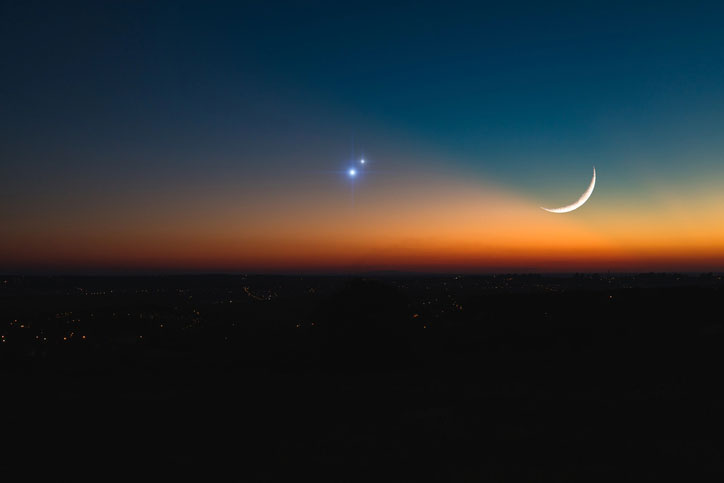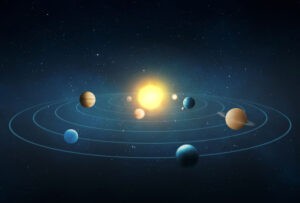

Planetary science is the study of micro-meteoroids, planets, and their moons in our own solar system. It looks at how these bodies were formed and their characteristics, including what they’re comprised of.
The ancient Greeks referred to planets as “wandering stars” because of how they would move across the sky annually. Every human civilization that looked up at the night sky, the Babylonians, the Chinese, the Indians, the Mayans, the Celts, and so on, noticed how five points of light –Mercury, Venus, Mars, Jupiter, and Saturn– moved rapidly across the sky over periods of weeks and months compared with the relatively slow yearly movement of the other stellar points of light.
The field of planetary science was revolutionized with the invention of the telescope in seventeenth century Europe. Further developments were made incrementally until the end of the 20th century when planetary science would take off in earnest, both literally and figuratively.
Planetary science can answer profound questions that relate to human philosophy, science, and religion:
- What’s required for life, and is the earth special among all other planets?
- Is there life, either biological or intelligent, somewhere else in the universe?
- What caused life on earth, and could similar conditions produce life elsewhere?
The answers to these questions are best framed within a liberal arts context. It’s the liberal arts perspective that is uniquely qualified to answer questions that arise when fields like biology, chemistry, physics and astronomy intersect with philosophy and religion.
History Through a Liberal Arts Lens Sheds Light on Early Advancements in Planetary Science
 Every human culture strives to makes sense out of the world they observe around them. This has always included the night sky and how several points of light in – that we now know to be planets – seemed to move faster than the others.
Every human culture strives to makes sense out of the world they observe around them. This has always included the night sky and how several points of light in – that we now know to be planets – seemed to move faster than the others.
Every early human civilization right up to the present has attempted to describe what they see in the night sky. Take Venus for example:
- The Sumerians knew Venus as the Goddess Inanna
- The Akkadians and Babylonians knew the planet as the Goddess Ishtar
- Christians knew it as the Virgin Mary, mother of Jesus
- The Persians knew the planet as the Goddess Anahita
- Islamic tradition referred to the planet as the Beautiful Woman
- The ancient Greeks referred to the planet as Phosphoros, the bringer of light
- The Mayans referred to it as the Great Star
Unfortunately for the world’s ancient civilizations, insights into the true nature of Venus and the other planets wouldn’t come until the invention of the telescope in Europe centuries later. But this doesn’t preclude the liberal arts as being the best means for understanding the cultural, religious, and philosophical importance of the planets in the time of antiquity.
The Telescope – A Liberal Arts Invention that Revolutionized Planetary Science
 The telescope was invented in seventeenth century Northern Europe and would change planetary science forever. It was a revolutionary invention in the best sense of the meaning.
The telescope was invented in seventeenth century Northern Europe and would change planetary science forever. It was a revolutionary invention in the best sense of the meaning.
The ancient Assyrians developed the first crystal lens. The Greeks had contact with Assyrian knowledge, and subsequently Muslim Caliphates preserved the knowledge of the Greeks. During the Renaissance in present-day Italy, much of the Spanish Muslim Caliphate knowledge was transferred to Catholic Southern Europe thanks to Spain’s religious intolerance of non-Christian Jews and Muslims. From Roman Catholic Italy, Renaissance ideas soon made their way to the ideologically-freer Protestant area of Northern Europe and the present-day Netherlands.
In 1608 Hans Lipperhey, a lens grinder who made eyeglasses, applied for a patent for a refracting telescope made from two strategically positioned magnifying lenses. Lipperhey was not the first person in his locale or era to try and patent a refracting telescope lens –who was actually the first remains a debate for historians– however the contenders for this distinction could have all bumped elbows in a local Dutch coffee shop in the early seventeenth century.
What’s clear is that once the telescope hit the market, contemporary thinkers immediately seized upon it to make discoveries in planetary science:
- In 1609 Galileo popularized and improved upon the Dutch telescope design using a convex lens and a concave eyepiece, which earned him tenure and a doubled salary at his university in Padua, Italy
- In 1611 the German astronomer Johannes Kepler made an improved telescope design with a convex objective lens and a convex eyepiece
- By the mid 1600s astronomers like the Dutch Christiaan Huygens were making further improvements on Keplerian telescopes
- In 1668 the Englishman Isaac Newton invented the first reflector telescope, also known as a Newtonian telescope
Planetary science really came into being with the invention of the telescope. It was at this point that people realized for certain that other planets like earth were orbiting the sun. Galileo discovered these planets had moons, like his namesake “Galilean” moons orbiting Jupiter: Io, Europa, Ganymede, and Callisto.
In fact, some let their imaginations run wild thinking about the existence of other planets like earth. The following is a headline caption from the New York Times in 1911:
“Martians Build Two Immense Canals in Two Years; Vast Engineering Works Accomplished in an Incredibly Short Time by Our Planetary Neighbors”
By this point, planetary science was well within the domain of the liberal arts. The realization that other planets existed was raising fundamental questions about humankind’s place in the universe, and these questions had implications for religion and philosophy. And that’s to say nothing of the intersectionality of geology, biology, chemistry, and physics when it comes to analyzing a planet’s environment.
Planetary Science Enters the Space Age – A Story of the Liberal Arts
 Over the century’s telescopes gradually improved but they would always be limited by size constraints as well as earth’s own atmosphere. The next paradigm shift in planetary science would come with the space age.
Over the century’s telescopes gradually improved but they would always be limited by size constraints as well as earth’s own atmosphere. The next paradigm shift in planetary science would come with the space age.
Every 175 earth years Jupiter, Saturn, Uranus, and Neptune align in such a way that it’s possible to visit them all with a strategically launched spacecraft. Taking advantage of this alignment, NASA launched Voyager 1 and Voyager 2 in 1977, missions that would return striking images of the outer planets.
What people saw both revolutionized theories of planetary science and inspired a generation of space enthusiasts to look up and wonder about our planetary neighbors in scientific and philosophic terms. The next time such an alignment will happen will be in the year 2152.
The Voyager missions made remarkable planetary science discoveries, including:
- Volcanic activity and water ice on Jupiter’s moons
- Jupiter’s rings and several new moons
- Saturn’s upper atmosphere contained less helium than expected
- Atmospheric measurements of Saturn’s moon Titan led to theories that it had liquid hydrocarbon lakes; these were later confirmed by the ESA’s Huygens lander
- 11 moons that orbit Uranus
- Canyons created by geological faults on Uranus’ moon Miranda
- Rings around Neptune
- Neptune’s mysterious Great Dark Spot that has since vanished
As we saw pictures of other planets beamed back by the Voyager missions with our own eyes, our neighboring planets and moons became simultaneously both more familiar through relatable geological features, and more distant because of their extreme environments that have no parallel on earth.
A new paradigm in planetary science began with the space age during the Cold War. The next fundamental discoveries in planetary science wouldn’t arrive until decades later with the advent of space telescopes.
The space race, a product of the Cold War, couldn’t be more emblematic of the liberal arts and sciences: through a bellicose competition we learned about our unique place in our solar system, which taught us about the preciousness of life, something that is as yet undetectable throughout the rest of the universe.
The First Exoplanet is Confirmed in 1992 with Profound Implications for the Liberal Arts
The same person who popularized the idea of a Martian civilization building canals on the red planet in the New York Times, Edwin Hubble, confirmed that galaxies existed outside our own Milky Way in 1924. Since then we’ve realized:
- There are at least 100 billion galaxies in the universe
- Within each galaxy there are hundreds of billions of stars; the number of planets outnumbers stars
- It’s estimated that at least 50 percent of stars have planetary systems
When you do the math this works out to the existence of billions and billions of planets; far more planets in the universe than grains of sand on all the beaches of earth, and that’s to say nothing of their moons and micro-meteoroids.
This means that right now is the most exciting time to be involved in planetary science.
And that’s thanks in no small part to the advent of space telescopes. In 1992 the first planets outside our solar system, exoplanets, were discovered using earth-based radio astronomy. Several other planets were discovered by earth-based means in the following decades, however the discovery of exoplanets was revolutionized by the Kepler Space Telescope.
By the time of its retirement in 2018, the Kepler Telescope had discovered 2,662 exoplanets over its near-decade lifespan. Kepler’s successor, the Transiting Exoplanet Survey Satellite (TESS) picked up where Kepler left of with first light in 2018. Since then, TESS has already identified over 2,600 candidate exoplanets.
Scheduled for launch towards the end of 2021, the James Webb Space Telescope is so advanced that it will be able to conduct an atmospheric analysis of exoplanets, bringing planetary science well into the 21st century.
Future discoveries in planetary science will shed light on our origins on this planet and the prospects for life on others. These issues demand expertise from fields like biology, physics, geology, and chemistry, and future discoveries will have implications on our place in the universe affecting religion, psychology, sociology, and philosophy. Planetary science is a perfect field for study in the context of a liberal arts education.






